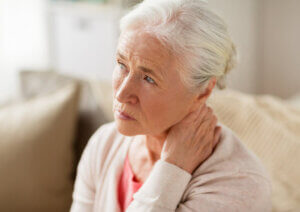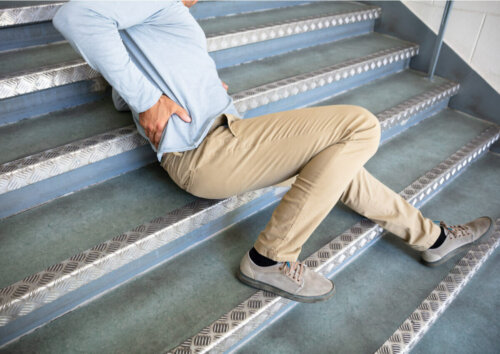What Are The Consequences of Sarcopenia?

As we get older, there are certain physical changes that occur in our bodies. Sarcopenia is one of these changes. Unfortunately, the consequences of sarcopenia manifest themselves in different ways on a day-to-day basis.
Up next, we’re going to analyze the most relevant changes that occur in a person who is getting older and has symptoms of sarcopenia. Despite being a change that cannot be fully fought against, it’ll be up to each person to try to limit the consequences.
Sarcopenia
Before analyzing the consequences of sarcopenia, we must first understand what we’re referring to by this concept. Sarcopenia refers to the loss of muscle tissue that a person suffers as they get older, as explained in the British Medical Bulletin.
In young people, muscle mass develops and strengthens. Later in life, it’ll be more or less stable for several decades. After that, a progressive degradation will begin.
It’s important to emphasize that we are talking about a natural process. Therefore, it’s different from pathologies in which muscle tissue is destroyed by the aggressive action of different chemical mediators.
In this case, it’s the loss of calcium in the muscle fibers that triggers a process that ends with the limitation of the contractibility of the fibers. Since lack of calcium is the cause, it’s a process that’s related to osteoporosis.
Consequences of sarcopenia

Being a process that gets worse over time, the consequences will become more serious as the years go by.
Less muscle strength: consequences of sarcopenia
First of all, we’ll state the obvious. As we lose muscle tissue, we’ll also lose muscle strength. This not only means not being able to lift heavy objects but also having trouble standing or staying upright in the long run.
Consider the fact that we have to have enough strength in our legs in order to stand and walk. If the muscles weaken, we may not be able to hold our bodies in place.
Increased risk of accidents
Due to the lack of strength that we mentioned before, the second consequence is a greatly increased likelihood of falling. Falling down is a grave threat for the elderly, as it can have very serious consequences.
The more strength the muscles lose, the less able they’ll be to keep the rest of the body standing. What’s more, if the back muscles also weaken and don’t keep us upright, the body’s weight distribution will vary. By putting more weight in front of the body, we’ll tend to fall forward.
Decreased quality of life
As sarcopenia progresses, there will also be a deterioration in the person’s quality of life. As we’ve seen, it can be difficult to walk. If we have difficulty walking, it can be hard to even move from the bed to the kitchen or bathroom.
Obviously, we’re talking about advanced cases. However, in milder stages, an elderly person will notice that they cannot lead their life as before. Moreover, let’s not forget that we need certain muscles to be healthy and strong to even breathe.

If the sarcopenia continues to advance, the final consequence is death. Muscle weakness cannot be underestimated, as it’ll incapacitate the person more and more. If it reaches the point that a person can’t get out of bed, the reality is that this person is in serious trouble.
What can we do to avoid the consequences of sarcopenia?
The best way to slow the progression of sarcopenia is clear: being physically active. It’s essential that older people continue to engage in daily physical activity, such as walking, aerobics, aqua gym, or Tai Chi.
Likewise, it’ll be convenient to perform simple acts, such as going up and down the stairs instead of using an elevator, or not always going to the nearest supermarket to buy groceries. Any excuse to do some more physical exercise will help in this regard.
On the other hand, we mustn’t forget that the better our physical state is before old age, the better our condition will be when we arrive at this stage. A person who leads a sedentary life will have a worse time when reaching old age. It’s important to take into account the importance of physical exercise throughout life, and not wait for signs of clear deterioration.
Finally, research published by the Journal of the American Medical Directors Association affirms that diet can also be an ally against sarcopenia. Eating enough calories and protein helps fuel your muscles properly.
As we get older, there are certain physical changes that occur in our bodies. Sarcopenia is one of these changes. Unfortunately, the consequences of sarcopenia manifest themselves in different ways on a day-to-day basis.
Up next, we’re going to analyze the most relevant changes that occur in a person who is getting older and has symptoms of sarcopenia. Despite being a change that cannot be fully fought against, it’ll be up to each person to try to limit the consequences.
Sarcopenia
Before analyzing the consequences of sarcopenia, we must first understand what we’re referring to by this concept. Sarcopenia refers to the loss of muscle tissue that a person suffers as they get older, as explained in the British Medical Bulletin.
In young people, muscle mass develops and strengthens. Later in life, it’ll be more or less stable for several decades. After that, a progressive degradation will begin.
It’s important to emphasize that we are talking about a natural process. Therefore, it’s different from pathologies in which muscle tissue is destroyed by the aggressive action of different chemical mediators.
In this case, it’s the loss of calcium in the muscle fibers that triggers a process that ends with the limitation of the contractibility of the fibers. Since lack of calcium is the cause, it’s a process that’s related to osteoporosis.
Consequences of sarcopenia

Being a process that gets worse over time, the consequences will become more serious as the years go by.
Less muscle strength: consequences of sarcopenia
First of all, we’ll state the obvious. As we lose muscle tissue, we’ll also lose muscle strength. This not only means not being able to lift heavy objects but also having trouble standing or staying upright in the long run.
Consider the fact that we have to have enough strength in our legs in order to stand and walk. If the muscles weaken, we may not be able to hold our bodies in place.
Increased risk of accidents
Due to the lack of strength that we mentioned before, the second consequence is a greatly increased likelihood of falling. Falling down is a grave threat for the elderly, as it can have very serious consequences.
The more strength the muscles lose, the less able they’ll be to keep the rest of the body standing. What’s more, if the back muscles also weaken and don’t keep us upright, the body’s weight distribution will vary. By putting more weight in front of the body, we’ll tend to fall forward.
Decreased quality of life
As sarcopenia progresses, there will also be a deterioration in the person’s quality of life. As we’ve seen, it can be difficult to walk. If we have difficulty walking, it can be hard to even move from the bed to the kitchen or bathroom.
Obviously, we’re talking about advanced cases. However, in milder stages, an elderly person will notice that they cannot lead their life as before. Moreover, let’s not forget that we need certain muscles to be healthy and strong to even breathe.

If the sarcopenia continues to advance, the final consequence is death. Muscle weakness cannot be underestimated, as it’ll incapacitate the person more and more. If it reaches the point that a person can’t get out of bed, the reality is that this person is in serious trouble.
What can we do to avoid the consequences of sarcopenia?
The best way to slow the progression of sarcopenia is clear: being physically active. It’s essential that older people continue to engage in daily physical activity, such as walking, aerobics, aqua gym, or Tai Chi.
Likewise, it’ll be convenient to perform simple acts, such as going up and down the stairs instead of using an elevator, or not always going to the nearest supermarket to buy groceries. Any excuse to do some more physical exercise will help in this regard.
On the other hand, we mustn’t forget that the better our physical state is before old age, the better our condition will be when we arrive at this stage. A person who leads a sedentary life will have a worse time when reaching old age. It’s important to take into account the importance of physical exercise throughout life, and not wait for signs of clear deterioration.
Finally, research published by the Journal of the American Medical Directors Association affirms that diet can also be an ally against sarcopenia. Eating enough calories and protein helps fuel your muscles properly.
All cited sources were thoroughly reviewed by our team to ensure their quality, reliability, currency, and validity. The bibliography of this article was considered reliable and of academic or scientific accuracy.
- J. Morley, J. Argiles, W. Evans et al. Nutritional Recommendations for the Management of Sarcopenia. Journal of the American Medical Directors Association. Volume 11, Issue 6, July 2010, Pages 391-396
- M. Narici y N. Maffulli, Sarcopenia: characteristics, mechanisms and functional significance, British Medical Bulletin, Volume 95, Issue 1, September 2010, Pages 139–159
- C. Cooper, R. Fielding, M. Visser et al. Tools in the Assessment of Sarcopenia. Calcified Tissue International. Vol. 93, 2013, Pages 201–210
This text is provided for informational purposes only and does not replace consultation with a professional. If in doubt, consult your specialist.








